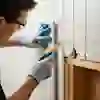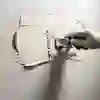Share:
Installing bathroom wall panels is a great way to transform your space, creating a waterproof, low-maintenance, and stylish alternative to tiles. Here, The Bathroom Showroom looks at the tools you’ll need while offering a simple step-by-step guide to help you through the installation process.

Tools You'll Need:
- Measuring Tools:
Tape measure
Pencil
Spirit level (to ensure panels are straight and aligned)
Straight edge
- Cutting Tools: (Choose based on panel material and preference)
Fine-tooth saw (hand saw, jigsaw, or circular saw for straight cuts)
Utility knife (for precision cuts and scoring thinner panels)
Hole saw (for cutting around pipes and fixtures)
- Adhesion & Sealing:
Panel adhesive (solvent-free, waterproof, and suitable for bathroom/wet areas)
Silicone sealant (neutral cure, low modulus, and often anti-fungal)
Caulking gun
Silicone finishing tool (for neat sealant beads)
Masking tape (to hold trims/panels temporarily and for neat sealing)
- Preparation & Safety:
Sandpaper (for roughing up panel backs and cut edges)
Cleaning supplies (sugar soap, microfiber cloth for cleaning walls/tiles)
Gloves and eye protection (essential for safety)
Dust mask (when cutting panels)
Sawhorse or workbench (for cutting panels)
- Optional (depending on wall condition):
Drill (if using a batten system or for mechanical fixings)
Timber battens (if your walls are uneven)
Screws/fixings (if using battens or for certain trim types)
Tanking system/waterproof membrane (especially for wet areas like showers)
Suction cups (can help with positioning larger panels)

1. Acclimatisation & Preparation:
- Acclimatise Panels:
Lay panels flat in the room for at least 24 hours before installation. This allows them to adjust to the room's temperature and humidity, preventing warping later.
- Prepare Walls:
Ensure walls are clean, dry, sound, plumb, and even. Remove any loose paint, wallpaper, or debris. If installing over existing tiles, ensure they are clean, dry, smooth, and free of soap residue. Fill any missing or badly damaged tiles.
For uneven walls, consider installing a timber batten frame first to create a flat surface for the panels to adhere to. In wet areas (like showers) consider applying a tanking system or waterproof membrane to the wall for added moisture protection.
2. Measure and Plan:
- Measure Thoroughly: Measure the entire wall area you intend to cover, taking measurements at the top, middle, and bottom.
- Plan Layout: Plan your panel layout to minimise cuts and ensure a visually appealing finish. Consider where joins will fall and how panels will meet corners or fixtures.
- Account for Trims: Remember to factor in the width of any corner or end trims you'll be using. Some recommend leaving a 15mm gap from edges for trims.

3. Cutting Panels:
- Marking: Mark your cutting lines clearly on the panel using a pencil and straight edge. For precise cuts around pipes or fixtures, use a template if needed.
- Cutting:
When using a hand saw, cut with the decorative face up to avoid chipping / When using a jigsaw or circular saw, cut with the decorative face down.
For thinner PVC panels, a sharp utility knife can be used to score and snap. For holes around pipes or shower valves, use a hole saw. Allow a 2-3mm expansion gap around any cutouts for pipes/fixtures and seal thoroughly.
- Sand Edges: Lightly sand any cut edges and the back of the panels (if recommended by the manufacturer) to create a coarse surface for better adhesive bonding.
4. Installing Trims (Corners and Ends):
- Cut Trims: Cut your corner and end trims to the desired height using a fine-tooth saw or hacksaw.
- Apply Sealant/Adhesive: Apply a small, continuous bead of silicone sealant or adhesive along the edges of the trim that will contact the wall.
- Fix Trims: Secure the trims to the wall. For corner trims, you might slide the first panel into one side, mark its position, and then fit the trim. Use masking tape to temporarily hold trims in place while adhesive sets.

5. Applying Adhesive and Fitting Panels:
- Apply Adhesive: Apply the panel adhesive to the back of the panel. Common patterns include three parallel strips along the length, a zig-zag pattern, or a continuous bead around the perimeter and then spaced horizontal beads. Some manufacturers recommend applying adhesive to the battens if you're using a batten system.
- Position Panel: Carefully lift the panel into place. If using a corner trim, slide the panel into the trim at an angle to prevent the foam tape (if applicable) from sticking prematurely.
- Press Firmly: Once positioned correctly, press the panel firmly onto the wall, ensuring full contact. You can use a squeezing motion to remove air pockets.
- Check Level: Use a spirit level to ensure the panel is perfectly level before the adhesive sets.
- Interlocking: For tongue-and-groove panels, apply a small bead of silicone sealant into the groove of the previously installed panel before slotting in the next. This creates a watertight seal.
6. Sealing Joints and Finishing:
- Seal Joints: Apply a continuous bead of silicone sealant along all panel joints, edges, and where panels meet trims, the shower tray, or the bath.
- Smooth Sealant: Use a silicone finishing tool or your finger (wearing a glove and dipped in soapy water) to create a neat, smooth bead of sealant. Wipe away any excess immediately.
- Repeat: Continue installing the remaining panels, repeating the measuring, cutting, adhesive application, and sealing steps.
- Curing Time: Allow the adhesive and silicone sealants to fully cure for 24-48 hours (or as per manufacturer's instructions) before exposing the panels to water or using the shower.
FAQs When Installing Bathroom Wall Panels:
What Type of Wall Panels Should I Use in the Bathroom?
Waterproof PVC, acrylic, and fiberglass panels are best as they resist moisture and mold growth. Avoid non-waterproof materials like real wood or MDF in wet areas.
Can I Install Panels over Existing Tiles?
Yes, in most cases, you can install panels directly over existing tiles, provided the tiles are clean, dry, sound, and flat. This can save significant time and mess. Ensure any high spots on the tiles are flattened.
What Is the Best Adhesive for Bathroom Wall Panels?
Look for adhesives specifically designed for bathrooms or wet areas. They should be solvent-free, waterproof, and often contain anti-fungal properties. "Pink Grip" (solvent-free version) and polymer/copolymer adhesives are often recommended.
How Much Space Should I Leave Between Panels and at the Perimeter Edges?
It's generally recommended to leave a small expansion gap (e.g., 2-3mm or up to 15mm depending on the panel type and manufacturer) between panels and around edges (where they meet walls, floors, ceilings, or fixtures) to allow for expansion and contraction due to temperature and humidity changes. These gaps will be covered by trims or sealant.
How Long Should I Wait Before Using the Shower After Installation?
Allow the adhesive and silicone sealants to fully cure, typically 24-48 hours, before exposing the panels to water. This ensures a strong bond and watertight seal.
How Do I Cut Panels Around Pipes or Windows?
Use a fine-toothed saw for straight cuts. For detailed cuts around obstacles like pipes or windows, a sharp utility knife or jigsaw is useful. Always mark precisely and allow for the expansion gap around cutouts.
What If My Walls Are Uneven?
If your walls have significant bumps or are very uneven, you may need to install a timber batten frame first. This provides a flat, level surface for the panels to adhere to. For minor imperfections, applying extra adhesive to problematic areas can help.
By following these steps and tips, you can successfully install bathroom wall panels and enjoy a beautiful, durable, and low-maintenance bathroom. For guidance on tackling further DIY bathroom tasks, check out our Help & Advice section.
